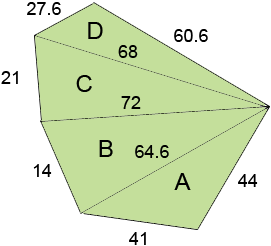 |
 |
|
Subject: Hexagon Area Dear Sir/Madam, Regards, Ashish
|
||||||||||||
|
Hello Ashish. This earlier question describes why just providing the lengths of the sides of an irregular polygon isn't enough information to determine the area. You'll need to provide more measurements, such as the length of at least three diagonals or several angles. Stephen La Rocque.> Ashish wrote back
Thanks Ashish, I drew a diagram (not to scale) of an irregular hexagon and added your lengths in feet.
The point of the diagram is to see that the diagonals divides the hexagon into four triangles which I have labeled A, B, C, and D. The area of the hexagon is then the sum of the areas of the four triangles. The area of each of the triangles can be found using Heron's formula. For a triangle with sides of length a, b, and c let s = (a + b + c)/2. Heron's formula is then
For the triangle A in the diagram I got
Using the same technique I found
Thus the area of the hexagon is 2843.3 square feet Penny |
||||||||||||
 |
 |
 |
